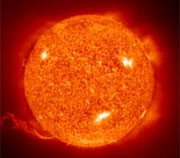What are sunspots?
[ 2006-05-22 10:34 ]
|

Astronomers are still learning about sunspots and about their affect on us, but
believe that the spots on the sun, which were first observed through
a telescope by Galileo in 1610, are electrical in nature. They base
this belief upon the known effects that sunspots produce, and upon
one astronomer's uncontested showing
that sunspots are whirlwinds of
electrified matter that burst out in pairs from the sun's interior.
Sunspots vary in size from what appear to be small specks on the sun's surface, to at least
90,000 miles long, and 200,000 miles in length, and are visible on
most clear days.
When sunspots release their electrical energy, they shoot beams
of negatively charged electrons into
space, some of which escape into the earth's atmosphere. These
electrons create electrical effects, such as the aurora borealis, or Northern Lights, cause the disruption of
radio transmissions, and increase the amount of ozone in the upper atmosphere. The additional
ozone may absorb more than the usual amount of the sun's heat, which
in turn may effect our weather.
The sunspot cycle, is a recurring 11-year period over which the
number of sunspots fluctuates and corresponds to the number of sun flares. An increase in the number of sun
flares leads to an increase in the number of sunspots, and a
decrease in the number of sun flares leads to a decrease in the
number of sunspots.
Records of sunspots have only been kept for the last 100 years or
so, leaving astronomers with little to back their research and much
yet to discover about this phenomenon.
|
|
note:
|
sunspot: 太陽黑子
uncontested: 無異議的
whirlwind: 旋風(fēng)
speck: 斑點(diǎn)
electron: 電子
aurora borealis, Northern
Lights: 北極光
ozone:
臭氧
sun flare: 太陽耀斑 | | |
|